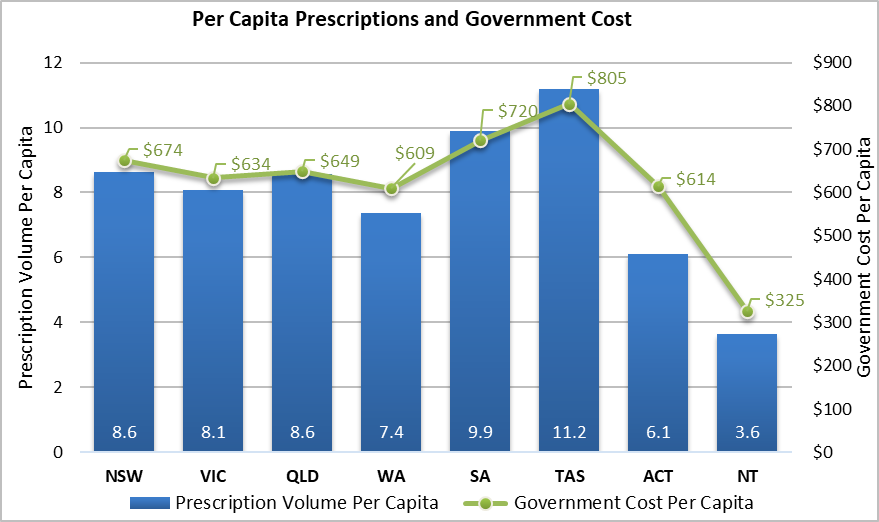PBS Expenditure and Prescriptions Report 1 July 2023 to 30 June 2024
Page last updated: 5 March 2025
Expenditure and Prescription Snapshot - 2023-24
|
Government expenditure was $17.7 billion for the supply of medicines. |
This represents 91.6% of total medicine costs and was up 6.1% from 2022-23. |
|
Patients contributed $1.6 billion to the cost of their medicines. |
This represents 8.4% of total medicine cost. |
|
226.5 million subsidised prescriptions[1] were dispensed. |
The number of subsidised prescriptions increased by 1.5% compared to 2022-23. The average dispensed price[2] per PBS subsidised prescription was $85.11 (up from $81.71 in 2022-23). |
|
Concession card holders:
|
Expenditure for this group was up from $10.5 billion (62.6%) in 2022-23. The average dispensed price for concessional cardholders was $58.93. The government contributed $54.34 towards the cost of each concession cardholder medicine on average. |
|
General patients:
|
Expenditure for this group was up from $6.2 billion (36.9%) in 2022-23. The average dispensed price for general patients[3] was $277.07. The government contributed $250.60 towards the cost of each general patient medicine on average. |
|
930 different medicines were listed on the PBS as at 30 June 2024. |
These medicines were spread across 5,164 brands. |
Key Statistics
This report details expenditure and prescriptions information relating to key elements of the Pharmaceutical Benefits Scheme. The information is presented on an expenditure (cash) basis for 2023-24, unless indicated otherwise. Data variables such as Patient Contribution, Total Cost and Average Price amounts do not include brand or therapeutic premiums[4].
PBS Expenditure is classified into the following patient categories[5].
|
Patient Category |
Patient Co-payment Amount |
|---|---|
|
General - Non-Safety Net (Ordinary) |
$31.60 |
|
General - Safety Net |
$7.70 |
|
Concessional - Non-Safety Net (Ordinary) |
$7.70 |
|
Concessional - Safety Net |
$0 |
Within the PBS, patients are categorised according to the cards that they hold when PBS benefits are supplied. General patients hold a Medicare card. Concessional patients hold a Medicare card and a: Pension Concession Card, Commonwealth Seniors Health Card, or a Health Care Card.
When patients and their family members spend a certain amount on PBS prescriptions (the safety net threshold amount) they can apply for a Safety Net Card and pay the reduced co-payment amount for their patient category for the remainder of the calendar year.
From 1 January 2024 the general patient safety net threshold amount was $1,647.90 and the concessional safety net threshold amount was $277.20.
Patients
Concessional patients accounted for the majority (88%) of prescriptions in 2024, but only 61% of Government expenditure.
Chart 1: Prescriptions and government expenditure by patient type 2023-24

The total cost of a medicine is the combined patient cost plus government cost. The average medicine cost is total cost (Patient and Government cost) divided by total PBS subsidised prescriptions. This value gives insight into the average total cost of a single PBS medicine, and it varies between different patient categories. The average total cost of medicines for concessional patients who accessed the Safety Net was six times less than the average total cost of medicines for general patients who did not access the Safety Net.
Chart 2: Average medicine cost by patient category 2023-24

Demographics
Over 178.6 million PBS prescriptions were dispensed to females and 152.5 million to males in 2023-24[6]. These figures correspond to government expenditure (for over-copayment contributions) of $9.0 billion and $8.6 billion respectively.
The number of PBS prescriptions dispensed increases as patient age increases. Most prescriptions (209.0 million or 63.1%) were dispensed to patients in the 60+ years-of-age group (Chart 3). All other age groups accounted for 122.1 million of the total 331.0 million subsidised and under-copayment prescriptions.
- The cost to government for patients aged 60+ years amounted to $10.5 billion (59.6%) of total government spending on medicines ($17.6 billion).
Chart 3: Prescriptions and government cost by gender and patient age, 2023-24

Notes: Approximately 1.1% of all prescriptions are excluded due to unknown patient demographic details.
Reported gender in the PBS Online Claims Data is sourced from Services Australia. Department of Health and Aged Care does not have access to Medicare personal records.
Geographic distribution
The distribution of PBS subsidised script volumes corresponds to the cost to government. New South Wales, Victoria and Queensland had the greatest script volume and expenditure in absolute value terms.
Chart 4: Prescriptions and government cost by State/Territory, 2023-24

On a per capita basis Tasmania and South Australia had the largest number of prescriptions and government expenditure.
Chart 5: Per capita prescriptions and government cost by State/Territory

- The Northern Territory and Australian Capital Territory had the lowest script volume and expenditure in both absolute value and per capita basis.
- The national average number of prescriptions was 8.4 per capita.
- The national average government cost was $653.29 per capita.
Recent patient cost saving measures
There are three key recent PBS Budget measures that operate to ensure that Australians have access to affordable medicines.
General Patient Co-Payment reduction
General Patient Co-Payment was lowered from $42.50 to $30.00 per PBS subsidised prescription from 1 January 2023 and is estimated to save patients over $280 million annually (Table 1).
- Patient co-payment and Safety Net thresholds are adjusted on 1 January each year in line with increases in the Consumer Price Index (CPI) and from 1 January 2024 the general patient co-payment amount is $31.60.
- While the reduction to the general co-payment increased the number of scripts required to reach the general patient Safety Net threshold, it means total patient costs are lower.
Table 1: Number of general patients, number of subsidised (above co-payment) prescriptions, and estimated patient savings from the lower co-payment for 2023-24[7]
|
General Patient Count |
Number of Subsidised Prescriptions |
Estimated Patient Savings |
|---|---|---|
|
4,116,252 |
22,292,305 |
$283.4 million |
60-Day Prescriptions
From 1 September 2023 patients with chronic, stable medical conditions can be prescribed and dispensed a 60-day supply of medicine (rather than a 30‑day supply) for eligible PBS items which is estimated to save patients around $54.4 million in 2023-24[8].
- Patients with a Medicare card and a concession card receive 60 days’ medication for the cost of 30 days, and only pay a single $7.70 co-payment.
- Patients with a Medicare card but don’t have a concession card who use medicines costing:
- $31.60 or more, receive 60 days’ medication for the cost of 30 days, and only pay a single $31.60 co-payment.
- less than $31.60, will not pay the same amount as for 30 days, but it will usually pay less than the cost for 60 days.
- 60-day prescriptions were introduced in three stages for certain medicines:
- Stage 1 medicines started from 1 September 2023.
- Stage 2 from 1 March 2024.
- Stage 3 from 1 September 2024 (Table 2).
- A full list of eligible medicines and stages is available on the Health website.
Table 2: PBS prescription counts for stage 1 and 2 medicines dispensed via 30-day and 60-day prescriptions supplied for 1 September 2023 to 30 June 2024[9]. Stage 3 was implemented from 1 September 2024, and information is therefore not included in the 2023-24 report.
|
Stage |
30-Day Prescriptions |
60-Day Prescriptions |
Total Prescriptions |
60-Day % |
|---|---|---|---|---|
|
Stage 1 |
87,131,129 |
8,241,065 |
95,372,194 |
8.6% |
|
Stage 2 |
9,154,038 |
327,116 |
9,481,154 |
3.5% |
|
Total |
96,285,167 |
8,568,181 |
104,853,348 |
8.2% |
Reduced Safety Net Threshold[10]
On 1 July 2022 the General and Concessional Safety Net Thresholds were lowered from $1,542.10 to $1,457.10 and $326.40 to $244.80 respectively, which is estimated to save patients in the order of $200 million annually[11].
- The number of PBS prescriptions required to reach the Concessional Safety Net threshold was lowered from 48 to 36.
Refences
[1] Includes subsidised prescriptions for concessional cardholders, general patients, and from the Doctors’ Bag.
[2] Patient payment plus Government benefit.
[3] General patients hold a Medicare card only and are not concessional cardholders.
[4] The PBS subsidises up to the price of the lowest priced brand for generic equivalents (except where the lowest priced brand has, as part of its price, a therapeutic group premium). This means that consumers may have to pay extra for more expensive brands (those with a brand premium). Consumers may have to pay extra for more expensive drugs (those with a therapeutic group premium).
[5] The Doctors’ Bag is an additional patient category, where medicines are provided to patients for emergency use for free by an approved supplier.
[6] PBS subsidised and under co-payment prescriptions (excludes Doctors’ Bag). These exclude approximately 1.1% of all prescriptions due to unknown patient demographic details.
[7] Notes and methodology regarding PBS Patient Co-Payment Reduction are at the Technical Notes.
[8] Notes and methodology regarding 60-day prescriptions are at the Technical Notes.
[9] Data for 60-Day prescriptions are not available for the full 2023-24 financial year as Stage 1 medicines only became available from 1 September 2023. Data excludes Stage 3 medicines, as they were introduced in the 2024-25 financial year.
[10] Per the Enactment of the Treasury Laws Amendment (Cost of Living Support and Other Measures) Bill 2022.
[11] Notes and methodology regarding estimated savings due to the reduced Safety Net threshold are at the Technical Notes.




